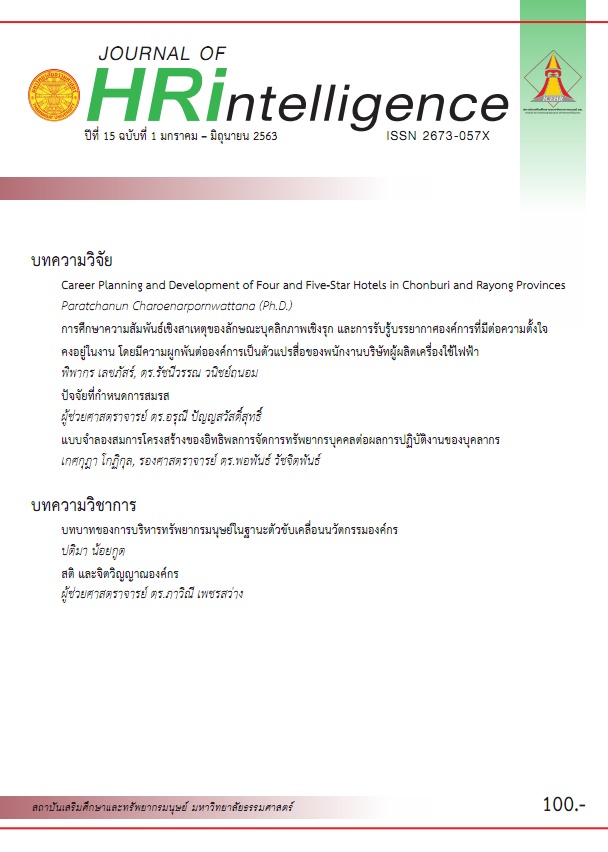ปัจจัยที่กำหนดการสมรส
Main Article Content
บทคัดย่อ
งานวิจัยนี้มีวัตถุประสงค์ที่จะศึกษาปัจจัยที่มีผลต่อการสมรสของประชากรไทยเพศชายและเพศหญิงแยกกัน โดยใช้ข้อมูลพาแนล 77 จังหวัด ระหว่าง พ.ศ. 2556–2559 ทั้งนี้ ปัจจัยที่คาดว่าจะมีผลกระทบต่ออัตราการสมรส ได้แก่ (1) ปัจจัยด้านประชากรศาสตร์ คือ อัตราส่วนเพศ (2) ปัจจัยด้านเศรษฐกิจส่วนบุคคล ได้แก่ ค่าจ้าง และระดับการศึกษา (3) ปัจจัยด้านเศรษฐกิจและสังคม ได้แก่ สัดส่วนของอัตราการว่างงานในเพศชายต่อเพศหญิง และสัดส่วนคนจน และ (4) ปัจจัยด้านสาธารณสุข ได้แก่ สุขภาพจิต (วัดจากอัตราผู้ป่วยโรคซึมเศร้า) สุขภาพกาย (วัดจากอัตราผู้พิการ) และภาวะอ้วนลงพุง ผลการทดสอบ Hausman test พบว่า แบบจำลอง random effect มีความเหมาะสมในการคาดประมาณแบบจำลอง โดยผลการคาดประมาณสมการปัจจัยที่กำหนดอัตราการสมรสของเพศชายพบว่า ค่าจ้างของเพศชาย ระดับการศึกษาของเพศชาย อัตราการว่างงานโดยเปรียบเทียบของทั้งสองเพศ อัตราผู้ป่วยโรคซึมเศร้า และความแตกต่างของท้องถิ่น (ผู้ชายในจังหวัดทางภาคเหนือและภาคตะวันออกเฉียงเหนือมีอัตราการสมรสสูงกว่าภาคกลาง) มีผลกระทบต่ออัตราการสมรสของเพศชาย โดยที่ทิศทางของผลกระทบเป็นไปตามสมมติฐานทุกปัจจัย ยกเว้นอัตราผู้ป่วยโรคซึมเศร้าซึ่งผลการคาดประมาณตรงข้ามกับสมมติฐาน เนื่องจากข้อจำกัดในการรวบรวมข้อมูล ส่วนปัจจัยที่ส่งผลกระทบต่ออัตราการสมรสของเพศหญิง ได้แก่ อัตราส่วนเพศ อัตราการว่างงานโดยเปรียบเทียบ อัตราผู้ป่วยโรคซึมเศร้า และความแตกต่างของท้องถิ่น (ผู้หญิงในจังหวัดทางภาคเหนือและภาคตะวันออกเฉียงเหนือมีอัตราการสมรสสูงกว่าภาคกลาง) โดยที่ทิศทางของผลกระทบเป็นไปตามสมมติฐานทุกปัจจัย ยกเว้นอัตราผู้ป่วยโรคซึมเศร้าเช่นเดียวกัน
Article Details
ขอมอบลิขสิทธิ์บทความที่ได้รับการตีพิมพ์ให้แก่สถาบันเสริมศึกษาและทรัพยากรมนุษย์ กรณีมีการฟ้องร้องเรื่องการละเมิดลิขสิทธิ์เกี่ยวกับภาพ กราฟ ข้อความส่วนใดส่วนหนึ่ง และ/หรือข้อคิดเห็นที่ปรากฎในบทความ ให้เป็นความรับผิดชอบของข้าพเจ้าและผู้เขียนร่วมแต่เพียงผู้เดียว
เอกสารอ้างอิง
Becker, G. S. (1973). A Theory of Marriage: Part I. Journal of Political Economy, 81(4), 813–846.
Becker, G. S. (1974). A Theory of Marriage: Part II. Journal of Political Economy, 82(2, Part 2), S11–S26.
Burgess, S., Propper, C. & Aassve, A. (2003). The Role of Income in Marriage and Divorce Transitions among Young Americans. Journal of Population Economics, 16(3), 455–475.
Chansarn, S. (2016). Socioeconomic Determinants of Divorce of Thai People: An Empirical Study in Provincial Level. In Chiang Mai University (Ed.), Proceedings of the 10th National Conference of Economists. Chiang Mai: Chiang Mai University.
Chiappori, P. A., Oreffice, S., & Quintana-Domeque, C. (2012). Fatter Attraction: Anthropometric and Socioeconomic Matching on the Marriage Market. Journal of Political Economy, 120(4), 659-695.
Chuanwan, S. & Katewongsa, P. (2014). Why Women Are Not Married: Where Have Men Gone Missing? In Y. Vorasiriamorn (Ed.), Proceedings of the 10th National Conference on Population and Society 2014. Birth and Security in Population and Society (pp. 23-42). Bangkok: Institute for Population and Social Research Mahidol University.
Coughlin, T. P. & Drewianka, S.D. (2011). Can Rising Inequality Explain Aggregate Trends in Marriage? Evidence from US States, 1977–2005. The B.E. Journal of Economic Analysis & Policy, 11(1), article 3.
Department of Provincial Administration. (2019). Statistics of Marriage Registration. Retrieved from https://stat.bora.dopa.go.th
Gould, E. D. & Paserman, M.D. (2003). Waiting for Mr. Right: Rising Inequality and Declining Marriage Rates. Journal of Urban Economics, 53(2), 257–281.
Grossbard, A. (1984). A Theory of Allocation of Time in Markets for Labour and Marriage. The Economic Journal, 94(376), 863–882.
Grossbard, S. (1993). On the Economics of Marriage: A Theory of Marriage, Labor, and Divorce. Boulder: Westview Press.
Grossbard, S. (2015). The Marriage Motive: A Price Theory of Marriage. How Marriage Markets Affect Employment, Consumption and Savings. New York: Springer–Verlag.
Hausman, J. A. (1978). Specification Tests in Econometrics. Econometrica: Journal of the Econometric Society, 1251-1271.
National Statistical Office Thailand. (2018). The Population and Housing Census. Retrieved from https://portal.nso.go.th/
OECD. (2019). OECD Family Database. Retrieved from https://www.oecd.org
Podhisita C., Varangrat, A., Gray, R., Vapattanawong, P. & Chuanvan, S. (2009). Nuptiality Change in Thailand, 1960 - 2000 :Implication for Future Fertility. Songklanakarin : E-Journal of Social Sciences & Humanities, 15(5), 703-722.
Sasaki, S. (2017). Empirical Analysis of the Effects of Increasing Wage Inequalities on Marriage Behaviors in Japan. Journal of the Japanese and International Economies, 46, 27–42.


